-
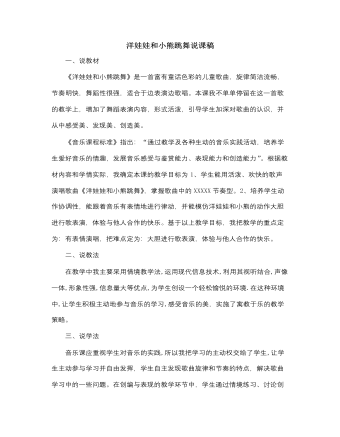
人音版小学音乐二年级上册洋娃娃和小熊跳舞说课稿
《洋娃娃和小熊跳舞》是一首富有童话色彩的儿童歌曲,旋律简洁流畅,节奏明快,舞蹈性很强,适合于边表演边歌唱。本课我不单单停留在这一首歌的教学上,增加了舞蹈表演内容,形式活泼,引导学生加深对歌曲的认识,并从中感受美、发现美、创造美。《音乐课程标准》指出:“通过教学及各种生动的音乐实践活动,培养学生爱好音乐的情趣,发展音乐感受与鉴赏能力、表现能力和创造能力”。根据教材内容和学情实际,我确定本课的教学目标为1、学生能用活泼、欢快的歌声演唱歌曲《洋娃娃和小熊跳舞》,掌握歌曲中的XXXXX节奏型。2、培养学生动作协调性,能跟着音乐有表情地进行律动,并能模仿洋娃娃和小熊的动作大胆进行歌表演,体验与他人合作的快乐。基于以上教学目标,我把教学的重点定为:有表情演唱,把难点定为:大胆进行歌表演,体验与他人合作的快乐。
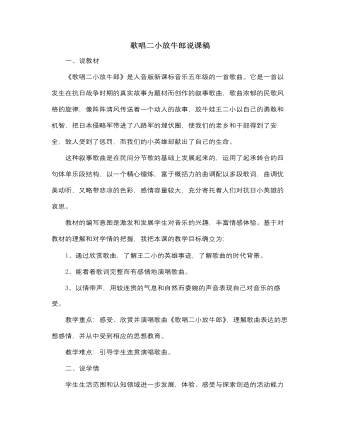
人音版小学音乐五年级上册歌唱二小放牛郎说课稿
一、说教材《歌唱二小放牛郎》是人音版新课标音乐五年级的一首歌曲。它是一首以发生在抗日战争时期的真实故事为题材而创作的叙事歌曲,歌曲浓郁的民歌风格的旋律,像阵阵清风传送着一个动人的故事,放牛娃王二小以自己的勇敢和机智,把日本侵略军带进了八路军的埋伏圈,使我们的老乡和干部得到了安全,敌人受到了惩罚,而我们的小英雄却献出了自己的生命。这种叙事歌曲是在民间分节歌的基础上发展起来的,运用了起承转合的四句体单乐段结构,以一个精心锤炼,富于概括力的曲调配以多段歌词,曲调优美动听,又略带悲凉的色彩,感情容量较大,充分寄托着人们对抗日小英雄的哀思。教材的编写意图是激发和发展学生对音乐的兴趣,丰富情感体验。基于对教材的理解和对学情的把握,我把本课的教学目标确立为:1、通过欣赏歌曲,了解王二小的英雄事迹,了解歌曲的时代背景。
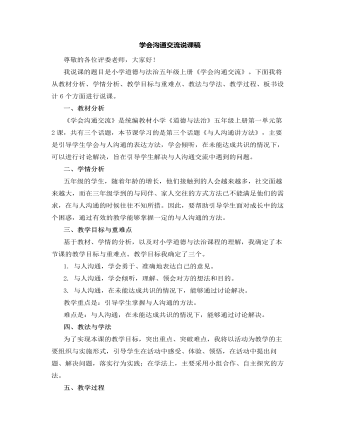
人教部编版道德与法制五年级上册学会沟通交流说课稿
然后,教师引导学生交流:你和同学沟通后,如果意见仍未达成一致,你会如何处理?板书:进行讨论,给对方充分解释的机会。设计意图:引导学生学懂得,与人沟通,在未能达成共识的情况下,要进行讨论,给对方充分解释的机会。环节三:课堂小结,内化提升学生谈一谈学习本节课的收获,教师相机引导。设计意图:梳理总结,体验收获与成功的喜悦,内化提升学生的认识与情感。环节四:布置作业,课外延伸将学到的与人沟通的方法应用到生活中。设计意图:将课堂所学延伸到学生的日常生活中,有利于落实行为实践。六、板书设计为了突出重点,让学生整体上感知本节课的主要内容,我将以思维导图的形式设计板书:在黑板中上方的中间位置是课题《学会沟通交流》,下面是:敢于表达、准确地表达;倾听的技巧;进行讨论,给对方充分解释的机会。

人教部编版道德与法制二年级上册团团圆圆过中秋说课稿
接下来,学生讲一讲自己和家人过中秋节时的内心体验,并用写一写、画一画、唱一唱等自己喜欢的方式来表达,之后,全班交流展示。板书:幸福 团圆设计意图:体会“中秋节,团圆夜”的中秋文化味道,明白中秋团圆之意义。环节三:快快乐乐咏中秋学生阅读教材第14页到第15页的绘本《古诗词中的月》,学生说说还知道的咏月思亲的佳句,也可以自己创作一两句儿歌。设计意图:学以致用,感受中秋文化所蕴含的人文情怀,感悟中华文化的魅力。环节四:感悟明理,育情导行学生谈一谈学习本节课的收获,教师相机引导。设计意图:梳理总结,体验收获与成功的喜悦,内化提升学生的认识与情感。环节五:拓展延伸,回归生活回家后,与爸爸妈妈分享课上学到的有关中秋的一些话题。设计意图:将课堂所学延伸到学生的日常生活中,有利于落实行为实践。
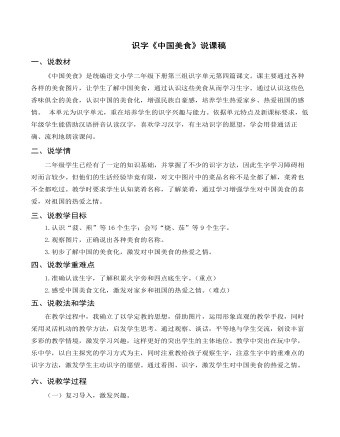
(说课稿)识字《中国美食》部编人教版二年级上册语文
一、说教材《中国美食》是统编语文小学二年级下册第三组识字单元第四篇课文。课主要通过各种各样的美食图片,让学生了解中国美食,通过认识这些美食从而学习生字。通过认识这些色香味俱全的美食,认识中国的美食化,增强民族自豪感,培养学生热爱家乡、热爱祖国的感情。 本单元为识字单元,重在培养学生的识字兴趣与能力。依据单元特点及新课标要求,低年级学生能借助汉语拼音认读汉字,喜欢学习汉字,有主动识字的愿望,学会用普通话正确、流利地朗读课问。二、说学情二年级学生已经有了一定的知识基础,并掌握了不少的识字方法,因此生字学习障碍相对而言较少。但他们的生活经验毕竟有限,对文中图片中的菜品名称不是全都了解,菜肴也不全都吃过。教学时要求学生认知菜肴名称,了解菜肴,通过学习增强学生对中国美食的喜爱,对祖国的热爱之情。
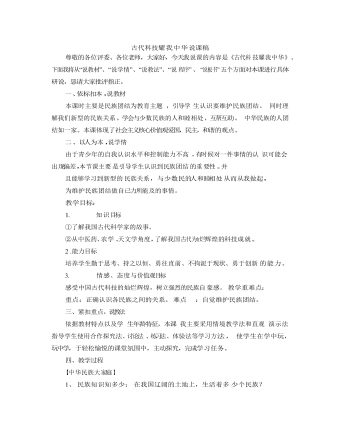
人教部编版道德与法制五年级上册古代科技,耀我中华说课稿
写 了中国历 史的辉煌篇章 。你知道哪些相关的事例呢 ?3、故事屋 : “彝海结盟”4 、小提示 :正是由于有各民族人民的艰苦奋斗 、团结互助 ,才有今天 这个伟大的多 民族国家一一中国。各民族在长期的历史发展 中,形成了 一 种相互依存的密切联系 ,我过经济今天取得的成就是各民族共同努力的结 果。5、相关链接 :课本第 58 页。6 、小提示:在长期实践和不 断交往中 ,各民族相互借鉴、相互欣赏 、 相互促进,共同创 造了光辉灿烂的中华文化 。7、活动园 :下面是 一一些同学查找到的各民族对中华文化贡献 的事例 , 你还能举出其他的事例吗 ?小结:我国是一个统一的多 民族国家,在长期的 生活和实践过程当中 , 各民族相互交往 交流交融 ,相互影响 、相互促进,共同努力建立和建设 了 社会主义新中国,并共同床在了 光辉灿烂的中华文 化。我们各民族是一个 共同体 ,谁也离不开谁。
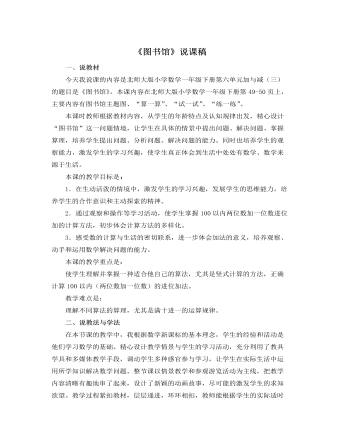
北师大版小学数学一年级下册《图书馆》说课稿
本课时教师根据教材内容,从学生的年龄特点及认知规律出发,精心设计“图书馆”这一问题情境,让学生在具体的情景中提出问题、解决问题、掌握算理,培养学生提出问题、分析问题、解决问题的能力。同时也培养学生的观察能力,激发学生的学习兴趣,使学生真正体会到生活中处处有数学、数学来源于生活。本课的教学目标是:1.在生动活泼的情境中,激发学生的学习兴趣,发展学生的思维能力,培养学生的合作意识和主动探索的精神。2.通过观察和操作等学习活动,使学生掌握100以内两位数加一位数进位加的计算方法,初步体会计算方法的多样化。3.感受数的计算与生活的密切联系,进一步体会加法的意义,培养观察、动手和运用数学解决问题的能力。本课的教学重点是:使学生理解并掌握一种适合他自己的算法,尤其是竖式计算的方法,正确计算100以内(两位数加一位数)的进位加法。教学难点是:理解不同算法的算理,尤其是满十进一的运算规律。
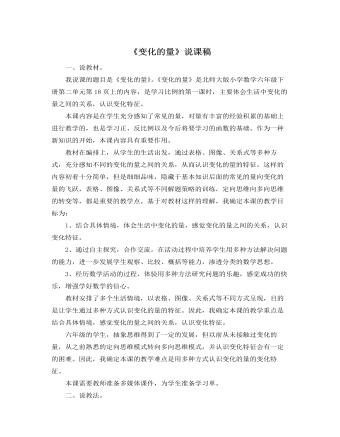
北师大版小学数学六年级下册《变化的量》说课稿
1、结合具体情境,体会生活中变化的量,感觉变化的量之间的关系,认识变化特征。2、通过自主探究,合作交流,在活动过程中培养学生用多种方法解决问题的能力,进一步发展学生观察、比较、概括等能力,渗透分类的数学思想。3、经历数学活动的过程,体验用多种方法研究问题的乐趣,感觉成功的快乐,增强学好数学的信心。教材安排了多个生活情境,以表格、图像、关系式等不同方式呈现,目的是让学生通过多种方式认识变化的量的特征。因此,我确定本课的教学重点是结合具体情境,感觉变化的量之间的关系,认识变化特征。六年级的学生,抽象思维得到了一定的发展,但以前从未接触过变化的量,从之前熟悉的定向思维模式转向多向思维模式,并认识变化特征会有一定的困难。因此,我确定本课的教学难点是用多种方式认识变化的量的变化特征。本课需要教师准备多媒体课件,为学生准备学习单。
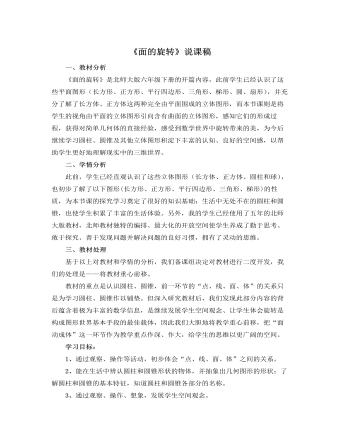
北师大版小学数学六年级下册《面的旋转》说课稿
2.放大空间,升华思考由于我对教材的二度开发留给了学生足够的探索空间,课上学生探索数学的热情被充分调动,我们欣喜地看到:有的学生尝试着不同平面图形的旋转;有的学生只用一种平面图形,却旋转出不同的立体图形;有的学生的思维并没有停留在表象上,而是在深入地思考产生这一现象的原因……交流时学生的发现远远超出了我们的想象,这份生成带给我们的是惊喜,是赞叹,更是“以操作促思考”的教学行为结出的硕果。3.巧用课件,形成表象本节课,我充分运用现代信息技术将平面图形经过旋转形成立体图形的过程生动、逼真地再现出来,帮助学生将抽象的空间想象化为直观,进而形成表象,深植于学生的脑海中,促进了学生空间观念的形成。总之,在这节课上,我坚持把“促进学生发展”作为第一要素贯穿于课堂教学的始终,让学生在充满着民主、探究、思考的氛围中,积极操作、主动思考,发展了学生的空间观念。
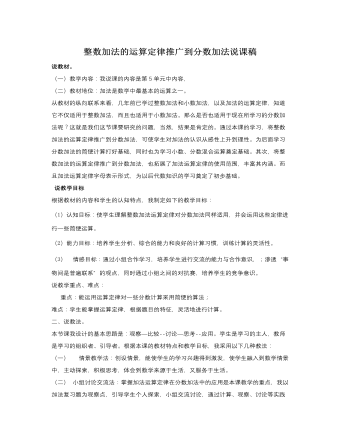
人教版新课标小学数学五年级下册整数加法的运算定律推广到分数加法说课稿
(一)教学内容:我说课的内容是第5单元中内容,(二)教材地位:加法是数学中最基本的运算之一。从教材的纵向联系来看,几年前已学过整数加法和小数加法,以及加法的运算定律,知道它不仅适用于整数加法,而且也适用于小数加法。那么是否也适用于现在所学习的分数加法呢?这就是我们这节课要研究的问题,当然,结果是肯定的。通过本课的学习,将整数加法的运算定律推广到分数加法,可使学生对加法的认识从感性上升到理性。为后面学习分数加法的简便计算打好基础,同时也为学习小数、分数混合运算奠定基础。其次,将整数加法的运算定律推广到分数加法,也拓展了加法运算定律的使用范围,丰富其内涵。而且加法运算定律字母表示形式,为以后代数知识的学习奠定了初步基础。

人教版新目标初中英语八年级上册Can you come to my party教案3篇
Step 3 (3b)First, tell the students when we talk about our future plans, we often use: I’m+verb+ing When we talk about what we must do, we use have to. Ask the students to fill in the blanks in 3b. The answers are: shopping, go to see, a test, I’m going, my family. Step 4 (3c)Let the students write an e-mail message to a friend. Say why you can’t visit next. Before the exercise, ask the students to give some possible answers and write them on the blackboard. So the students will feel easy to finish the writing exercise. After they finish it, Let them to correct it in groups first. Each group chooses theirs best one to read in front of the whole class. Step 5 ( planning a party )First read the conversation in the box together. Then ask the students to turn to page 88.Write down everything you have to do next week. Write in all the things you have to do . Ask the students to look at the list. Ask them “What day are you free?” This is when you can have your party. Step 6 (Self check 1 )Let the students to fill in the blanks with the words given. Change the forms of the words if possible. Then make their own sentences. The answers are: visit, playing, have to, study, comeStep 7 (Self check 2)Imagine you are Marie. Read the information and look at your schedule. Write replies to the invitation.

人教版新目标初中英语八年级上册How do you make a banana milk shake教案2篇
1. First, ... then, ... next, ... finally, ...首先,……然后,……接着,……最后,……这是英语中表达做某事的步骤的一种说法。如果步骤较多,还可以说:first-next-after that-later on-finally/at last通常你会听到说英语国家的人在说 first, next, then, finally 和后面的内容时,他们会做一些停顿。这样就能提前告诉听者接下来讲的是一系列的步骤。这一点在朗读和听力中应特别注意。2. how many, how much均为疑问词,同是“多少”,但用法不同。请看:how many修饰可数名词复数,how much修饰不可数名词。但在用法上,同学们常犯如下错误:1) [误] How many are there bananas on the table?[正] How many bananas are there on the table?[析] how many, how much 中的many,much是形容词,常修饰名词作定语,故后面跟名词。2) [误]How much tea are there on the table?[正]How much tea is there on the table?[析] how much修饰不可数名词时,谓语动词用单数。how many与how much的区别可简记为:前how many:问“多少”,复数名词后面跑;how much问“多少”,不可数名词单数好。前者答语用基数词,后者答语用数量关系。

人教版新目标初中英语八年级上册How was your school trip教案2篇
“Go for it!” is based on “Task-Based Language Teaching”. It adheres to “The authenticity principle”, “The form-function principle”, “The task dependency principle” and “The principle of learning by doing”. These principles all accord with the demands of curriculum focus.In and of Grade Seven (II), “Go for it!”, students have learned “The Simple Past Tense”. And it appears again in of Grade Eight (I). teaches students more about how to talk about events in the past. In addition, it gives affirmative and negative statements in the past tense, such as the sentence patterns “Did you see …?” “Were there …?” “Did you go …?” As the first part of Unit 8, Section A opens with a picture presenting the last school trip in the aquarium and continues with several step-by-step practice activities, which are all good for students to master “The Simple Past Tense”. Doing well in Section A will help students integrate the new target language with that in Section B. Thus, they can describe the events in the past freely and foster their own ability of reflecting and practicing. II. Teaching ObjectivesTeaching objective is the beginning and aim of teaching activities. According to the overall goal of the English elementary course--- improve students' synthetic ability of language application, which should be based on the development of students’ “Language knowledge”, “Language skills”, “Character building”, “Learning strategies” and “Cross-cultural awareness”. The teaching objectives are described as follows(I). Knowledge objectivesi. Master the simple past tense of regular and irregular verbsii. Recite the new words and expressions about the last school trip in the aquarium, including their pronunciation and intonation

人教版新目标初中英语八年级上册Could you please clean your room教案3篇
一、 教学内容Section A 1a----1c二、 教学目标1.学习词汇do the dishes, make the bed, take out the trash, fold the clothes, do the laundry, sweep the floor, clean the living room.2.句型 Could you please clean your room? Yes, sure.三、 教学准备 学生预习本单元所有的词汇多媒体课件 活动表 奖品四、 教学过程Pre-task1. Warming upEnjoy ourselves. Watch cartoon Cinderella. 看动画片段《灰姑娘》导如入本课话题和新词汇“chores”美丽善良的鬼姑娘因继母的嫉妒,每天得做所有的家务。片段的主题使学生联想到本课的话题。2. learn new words and phrasesLook! What is she / he dong? 看图学习动词词组do chores, do the dishes, make the bed, take out the trash, fold the clothes, do the laundry, clean the living room.3. Guessing game.What is she doing ? 4. Pair work. 1a, Do you do these things at home? Write “Y” for “yes” and “N” for “no”.5. Listening . 1b , Peter’s chores or Mom’s chores?理解目标语Could you please clean your room? Yes, sure.Write “M” for Mom’s chores, “P” for Peter’s chores in the chart.6. PairworkLook at the picture,Ask your partner to do the chores that you see. 7. Interview Who is the most able at home? 1) What chores do you do at home? How often do you do the chores? Work in four, interview each of the students in the group, fill in the chart.

人教版新目标初中英语八年级上册How do you get to school教案2篇
Step Ⅶ Role play ( Work on 1b)1. First ask two students to read the dialogue to the class.Sa: How do you get to school?Sb: Well, I ride my bike to the subway station. Then I take the subway.2. Now work with a partner.Suppose you use two kinds of transportation to get to school \Hangzhou\Beijing... (bus, train, subway, walking, bike, etc.) Tell how you get there. You may use the phrases in 1a.3. Then ask different pairs of students to present their conversations to the class.Step ⅧListening1. Work on 2a(1) First ask students to read the list of information that Thomas wants to know.…where Nina lives.…how far from school she lives.…how long it takes to get to school.…how she gets to school.…what she thinks of the transportation.(2) Tell students what transportation and bus stop mean.bus stop 汽车站 transportation n. 运送;运输Then tell students we'll hear a recording. Please put a checkmark in front of each thing that Thomas wants to know.(3) Now play the recording for students.( Have students pay attention to the sample answer.) (4) Then correct the answers.

人教版新目标初中英语八年级上册What are you doing for vacation教案2篇
Teaching goals : 1. Words & phrases: babysit ,get back , fishing , rent , think about , decide(on) , tourist etc. 2. How to talk about future plans . 3. 现在进行时表示将来计划或行动. 4. 特殊疑问句(where , when , how long引导) Important and difficult points : Drills :What are you doing for vacation ? I’m watching TV . When are you going ? I’m going … . How long are you staying ? We’re staying for five days . Teaching aids : cards and a tape ,a large wall calendar . Period 1 Teaching procedures : Step 1Leading in1. Free talk . 2. Put up the wall calendar . T: I’m staying home on Saturday (pointing to next Saturday ).Ss repeat . Ss: I’m staying home on Saturday . T: OK. Today we’ll learn how to talk about future plans. Step 2Pre-task SB Page 13 , 1a . 1. Look at the picture carefully and tell what you see in the picture . 2. Write the activities from the pictures in the box and add some more . 3. Practice reading . Step 3While-task1. Using the activities we write in 1a to make conversations .For example :What are you doing for vacation ? I’m visiting my uncle . 2. Pairwork .Practice in pairs . 3. 用第三人称练习对话.

人教版新目标初中英语八年级上册I’m going to be a basketball player教案3篇
教学目标1.知识目标:(1)学习What are you going to be when you grow up?/How are you going to do that?句式。(2)学会用英语描述有关职业的表达法。2.能力目标:(1)能够谈论为实现理想所做出的打算和安排。(2)能够谈论未来自己与他人理想的职业及原因。(3)能用英语描述课余时间的活动安排,最终具备表达综合信息的能力。3.情感目标:新学期到来之际,让他们在学习、体育、饮食、特长、读书等方面制定计划,教育学生合理安排自己的课外生活,思考自己的理想职业及适合自己的职业。教学重点、难点本单元的重点为“be going to”表将来,want to be, what,where, when,how引导的特殊疑问句。难点是语言目标的实现。教材分析本单元以I am going to be a basketball player为话题,共设计了三部分的内容:一、Section A该部分有4个模块。第一模块围绕Do you think these jobs are interesting?这一话题展开思维(1a)、听力(1b)、口语(1c)训练;

人教版新目标初中英语八年级上册I’m more outgoing than my sister教案2篇
1 交通工具的比较此活动为小组活动。学生通过讨论找出到达某一城市可乘坐的各种交通工具,并选择最佳出行方式。Teacher:We’re going to Shanghai. How many ways can we use to get there? Yes, there are four ways: by bus, by plane, by train, by ship. Please discuss how you are going to get there.操作建议:(1)学生以小组为单位展开活动,谈论本组所选择的交通工具。(2)各组选代表向全班汇报,阐述本组所选择的交通工具的利和弊。完成任务所需要的语言结构:We can go there by ship. It’s more comfortable and cheaper than any other transportation.We can go there by bus. It’s cheaper but it takes longer time.2 哪个城市更合适?此活动具有挑战性。假设中国要举行2014年世界杯足球赛,分别从历史,人文,天气等方面对各城市(北京,大连,上海,昆明)进行比较,选择最佳举办城市。T: Imagine China is holding the 2014 FIFA World Cup. Which city do you think is the best for the World Cup, Beijing, Dalian, Shanghai or Kunming? Let’s work in groups. If you choose Beijing, please join the Team Red. If you chose Dalian, please join the Team White. If you choose Shanghai, please join the Team Blue. If you choose Kunming, please join the Team Green. Please show us its advantages. Then let’s see which team will win.

人教版新目标初中英语八年级上册What’s the best radio station教案2篇
教学重点和难点:运用所掌握的语言描述,比较不同地点的特点。在练习中学习掌握英语比较级和最高级的用法。课前准备分配小组,每组五至六人。通过上网或翻阅报刊杂志等方法,确定旅游线路,做出基本的旅游计划。教学设计:本节课流程图 学法指导:1.由于这是一堂新课,在教学中应注意面向全体,发挥学生的主体性,引导学生积极参与,激发学生的求知欲和学习积极性,指导学生积极思维,主动获取知识,养成良好的学习方法。逐步学会独立解决问题。总之要尽可能调动学生的非智力因素促进智力因素的发展。教法选择:1.电化教学法2.课堂讨论法3.任务型教学法采用这些方法的目的是为了充分调动学生的学习积极性,使学生变被动学习为主动学习。通过电脑形象的演示,加强印象,提高兴趣,突破难点,提高教学效率,进而增大教学的容量和信息量。充分体现教师为主导,学生为主体的教学原则。

人教版新目标初中英语八年级上册What’s the matter教案2篇
She shouldn’t go to the party tonight.Step7. TaskT: You know, there are lots of problems in our life. If you are a doctor, please tell us how to solve the problem. I will divide you into 9 groups. Please work in groups. And then choose one of you to report your ideas.The following are the problems:I have a toothache.I am hungry. I have a sore throat.I am stressed out. I have a sore back.I am tired. I can’t sleep.I have a cold. I have a headache.Report: If you have a headache, you should go to bed early. You should see the doctor. You should eat some medicine. You shouldn’t wash your face with cold water.You shouldn’t sleep late.You shouldn’t swim.…..T encourages the students to give advice as much as possible.Homework:1. Chose one of the problems, and write down your advice2. Copy the new words这一步是用于热身的,同时也可以让他们复习一部分的表示人体部位的单词,扩充知识.学习语言的过程也是一个不断积累的过程,复习旧知识,增添新知识.通过小游戏,强化学生对Does she/he have…这个句子的运用能力.通过复习,自然的引到下面新知识的学习。充分利用表格,由句子到对话,再到文章,让学生循序渐进. 提高学生的综合语言运用能力,运用以前学过的知识来解决身边的问题.Period 5 (Section B 3a—3c, selfcheck)教学内容与分析:

